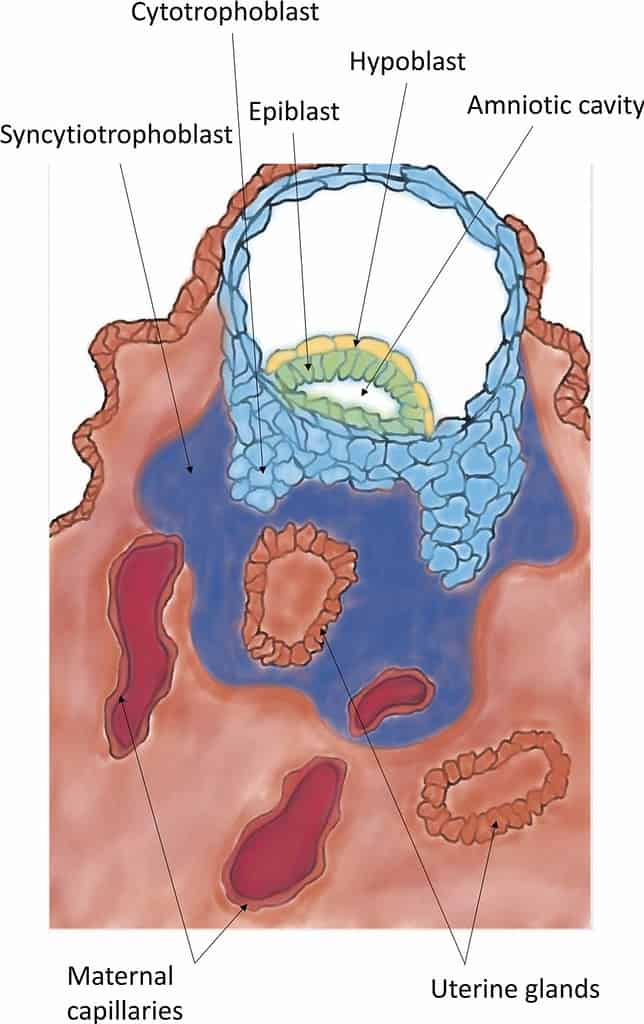Delayed implantation, also called embryonic diapause, is when mammals pause their pregnancies until conditions are better for the survival of their offspring.

During delayed implantation, the blastocyst embryo does not implant into the mother’s uterus, but instead, remains dormant.
©https://www.sciencedirect.com/science/article/pii/S1084952122001215?via%3Dihub#fig0025 – License
Delayed Implantation Meaning
Some animals can pause the development of their embryo at an early stage of development. Scientists believe animals do this to wait for better conditions for success in having and raising their young. Research has shown over 130 species of mammals, and some marsupials, are capable of delaying their implantation.

The embryos of rodents can also go through a dormant period.
©59816/Shutterstock.com
How Does Delayed Implantation Work?
The gestational period is the amount of time between conception and birth. It varies widely between species. Although this is usually for a set amount of time, some female animals can pause the development of the embryo to delay birth.
The process begins when the embryo is at the blastocyte stage. When an egg is fertilized, the cells begin to divide. A blastocyte is a cluster of dividing cells at the beginning of embryo development. During the process, the blastocyst embryo does not implant into the mother’s uterus, but instead, remains dormant.
The cells freely drift around inside the uterus until something signals the embryo to implant and begin development.
What Are the Two Types of Delayed Implantation?
There are two ways an animal may delay implantation. These are facultative diapause and obligate diapause.
Facultative diapause often occurs when an animal has mated shortly following the birth of a litter. For example, the hormones released in the mother’s body during lactation of a litter of pups will halt the blastocyte embryo from developing. But once the pups have weaned, the embryo will implant in the mother’s uterus and begin development.
Obligate diapause is also called seasonal delayed implantation. In this type, the animal’s hormones are affected by the number of daylight hours. During winter, the short days signal the release of certain hormones, which delay the embryo from implanting. But during spring, when the days grow longer, the embryo will implant in the uterus and begin development. This ensures the babies will be born during the warmer spring months when food is plentiful, rather than during a harsh winter.
What Are Some Examples of Animals That Experience Delayed Implantation?

The bears mate in the summer, but they delay implantation until the beginning of winter.
©Debbie Steinhausser/Shutterstock.com
The western spotted skunk is one animal that can delay implantation. Western spotted skunks mate in the fall. However, spring is a more advantageous time for babies to be born. The female skunk stores the embryo during winter until the seasons change and it becomes more advantageous to give birth.
Black bears are another example of delayed implantation. The bears mate in the summer, but they delay implantation until the beginning of winter. Mother bears need to prepare their bodies for pregnancy and birth by eating the abundance of food available during the summer. Once the bears are nutritionally ready, hormones trigger the blastocyte to implant.
The embryos of rodents can also go through a dormant period. If the mother faces stress or inadequate food supplies, the pregnancy may be delayed until the surroundings improve, and the mother’s fat supply builds up, readying her for pregnancy.
The European badger is another example. Badgers tend to mate year-round, although the female typically gives birth in winter. Although the gestational period for the badger is about six to eight weeks, the female badger may delay implantation for as long as eleven months. Once the shorter days of winter trigger hormonal signals in the mother, the embryo will implant in the wall of the uterus and begin developing.
How Humans Can Benefit From Studying Delayed Implantation in Animals

Understanding how delayed implantation works in animals may help researchers better understand treatments in humans, such as IVF treatments, and how to treat cancer.
©bezikus/Shutterstock.com
Researching how animals delay implantation has helped scientists to learn more about human reproduction, stem cells, and cancer treatments. Understanding how it works in animals may help researchers better understand treatments in humans, such as IVF treatments, and how to treat cancer. For example, studying delayed implantation may help scientists learn how to inhibit cancer cell multiplication.




